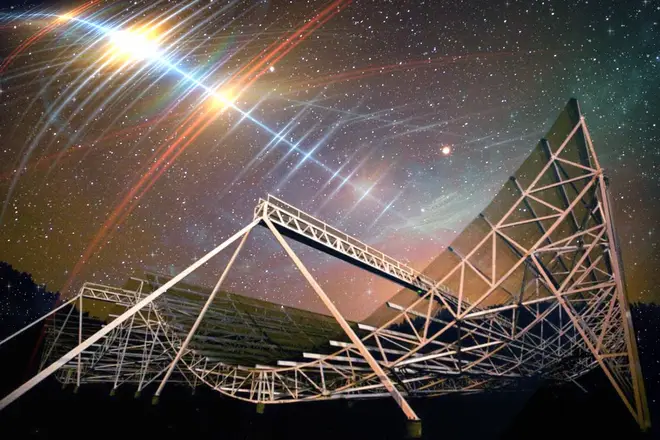Scientists have detected a mysterious radio signal from a galaxy far, far away
20 July 2022, 16:21 | Updated: 20 July 2022, 16:47

Listen to this article
Intense bursts of radio waves have been picked up by the CHIME radio telescope, and traced back to a distant galaxy.
Astronomers from the Massachusetts Institute of Technology (MIT) have discovered a “strange and persistent” radio signal, emanating from deep in outer space.
The origins of the pulsing radio waves remain a mystery, but researchers say it comes from another galaxy several billion light-years away.
In an oddly lifelike metaphor, the regular pulse of the radio waves has been compared to a heartbeat, with bursts occurring every 0.2 seconds in a “clear periodic pattern”.
The signal is classified as a ‘fast radio burst’ (FRB), which is an emittance of radio waves which usually last for a few milliseconds at a time. What exactly causes these bursts is still not fully understood.
Read more: NASA releases eerie ‘singing’ from a black hole and it’s straight out of a horror movie

The discovery was made by Daniele Michilli, a postdoctoral candidate at MIT, after the unusual data captured his attention on 21 December 2019.
As he recalls, “there were periodic peaks that were remarkably precise, emitting every fraction of a second – boom, boom, boom – like a heartbeat”.
Previously discovered FRBs have been periodic in their cycles of appearance, but Michilli says that “this is the first time the signal itself is periodic”.
Unusually, this FRB has also been recorded as lasting up to three seconds – roughly a thousand times longer than average. Labelled the FRB 20191221A after the date of Michilli’s discovery, MIT researchers have called it the “longest-lasting FRB, with the clearest periodic pattern, detected to date”.
Read more: 7 times classical music was inspired by space
Scientists have a number of theories as to the astrophysical origins of these radio pulses, but most point to radio pulsars or magnetars as the most likely source. These are both types of neutron stars, which are created when giant stars collapse to form “extremely dense, rapidly spinning” masses.
According to Michilli, “there are not many things in the universe that emit strictly periodic signals, and we think this new signal could be a magnetar or pulsar on steroids”.
As more research is released, and more advanced telescopes developed, this intriguing discovery could lead to new and deepened understandings of the universe’s history and expansion, as well as further knowledge of FRBs and neutron stars themselves.

CHIME Fast Radio Bursts
Despite being a recent discovery, FRBs are by no means a rare phenomenon. Victoria Kaspi, director of the McGill Space Institute and physics professor at McGill University, says that an estimated 1,000 bursts are going off each day, but most telescopes can only see a small portion of the sky and pick up these occurrences purely by chance.
The first FRB was discovered in 2007 by Duncan Lorimer and David Narkevic, and hundreds more have been discovered in the 15 years since. Most originate from other galaxies, but in 2020 the CHIME radio telescope picked up a signal coming from within the Milky Way.
The same telescope is responsible for this mysterious signal, too. Named the Canadian Hydrogen Intensity Mapping Experiment (CHIME, for short) and residing in British Columbia, the telescope was originally built to map hydrogen atoms across the universe with the aim to learn more about the history of its expansion.
This technology also makes it extremely good at detecting radio waves from deep within the universe, as it has the sensitivity to track almost all the known pulsars in the northern celestial hemisphere.


































